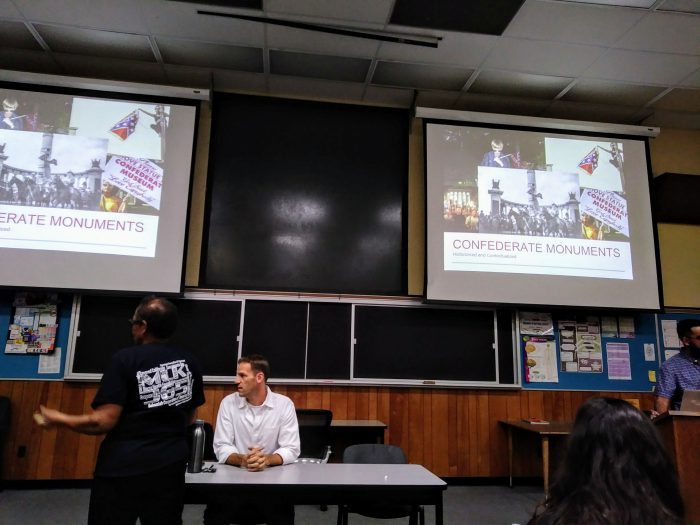
Last week, Crossing Borders Building Bridges (CBBB), a series of presentations dealing with a range of social issues, hosted a lecture presented by Yuba College history professors Rajan Gill and Travis Smith.
The lecture was titled “Confederate monuments and the Jim Crow era,” and included a brief summary of Confederate monuments in the South, their symbolical impact on modern American society, and a discussion panel.
Gill opened the presentation with a brief history of Confederate monuments in America. He explained that the erection of such monuments, which celebrate the American South’s Confederate soldiers who fought during the Civil War, happened in two main phases: during the Lost Cause movement, and the Civil Rights Movement.
Gill explained that the placement of Confederate monuments during the Lost Cause Movement coincided with the rise of the Jim Crow Era.
As Gill described the Jim Crow Era, an image of a massive lynch mob crowd filled the screen. Hundreds of Americans were gathered around the dead body of an African American hanging from a rope. Gill explained how such lynchings were entertaining to Americans.
Gill described a particular lynching where a man was burned and his bones fought over by the crowd of onlookers. There were several gasps from the audience in the room, a few murmuring “wow” and “oh gosh” under their breaths.
Gill then proceeded to talk about the recent white supremacist protest in Charlottesville. The protest itself, Gill explained, stemmed from anger against the Charlottesville city council’s decision to take down a Robert E. Lee monument.
When trying to explain the Charlottesville protest during the discussion panel, Smith joined the conversation and broke down what he referred to as “American ideals.” In his explanation, Smith compared civic ideals to racial ideals. He explained how racial ideals, like the ones in motion in Charlottesville, are based on the notion that white Americans continue to be superior. Civic ideals, on the other hand, value diversity and believe that America was founded on it.
“What holds us together,” Smith added, “are our civil ideals.”
As the discussion continued, the question about what should happen to these Confederate monuments arose. One audience member, Alice Johnson, responded by recalling her recent experience when visiting the state of Virginia.
Johnson said, “It doesn’t make a difference to take down monuments, it’s the people’s mindset.”
The statement lingered in the air as the professors and the audience pondered Johnson’s statement. With further discussion, a second question was brought up: how do you change this mindset?
“It’s okay to understand there are parts in one’s history that are positive, and it’s okay to understand there are parts in one’s history that are not so positive.” Smith explained.
As the discussion continued and more audience members shared their input, a third question was brought to light: how do you talk about this subject with people who believe these monuments are a part of southern heritage?
As the term “political correctness” began being tossed around, Gill shared his own definition of the word.
“Basically, all political correctness is” Gill explained, “is just a way of interacting with people who think differently than you.” Gill continued to suggest that it acts as a “code of conduct that allows us to coexist.”
With the lecture wrapping up in a short hour, the presentation left the audience with much to think about.
CBBB hosts a variety of presentations, lectures, and events on campus, usually on Tuesdays and Thursdays at noon.
Comment Policy: Comments are welcomed and encouraged. However, the editorial board reserves the right to edit or delete, without notice, any comments submitted to the blog. For more details, see our full Comment Policy.